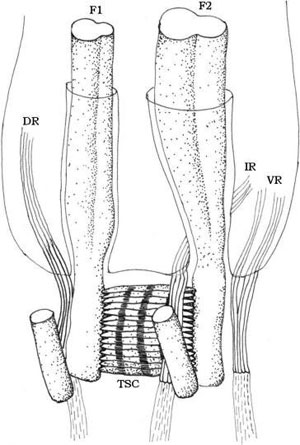Euglenophyta

FIGURE 2.55 Root system of Euglenophyta. F1 and F2: flagella; DR, dorsal root; IR, intermediate root; VR, ventral root; and TSC, transversely striated connective.
Euglenoids show a rather uniform root structure, with one microtubular root opposite each basal
body and a single microtubular root in between, termed dorsal, intermediate, and ventral roots
(Figure 2.55). The dorsal root is anchored to the dorsal basal body at the side furthest from the
ventral basal body; the intermediate and ventral roots are both associated with the ventral basal
body at its dorsal and ventral sides, respectively. In Euglena mutabilis, the dorsal and the intermediate roots consist of three microtubules, while the ventral root consists of five microtubules; in E. gracilis, the ventral root is formed by five microtubules as in E. mutabilis, while the microtubules of the dorsal root are more numerous. These roots extend from the basal bodies along the reservoir and into the cytoplasm, usually along the cell periphery, but in some species towards the nucleus. Flagellar roots are believed to play an important role in maintaining the cell shape. In some species the two flagellar basal bodies are connected by a conspicuous transversely striated connective.

FIGURE 2.55 Root system of Euglenophyta. F1 and F2: flagella; DR, dorsal root; IR, intermediate root; VR, ventral root; and TSC, transversely striated connective.
Besides the intraflagellar accessory structures described above, euglenoids with two emergent
flagella possess extraflagellar accessory structures, the so-called rootlets. Two major classes of
rootlets have been described: microtubular rootlets and filamentous rootlets. Microtubular rootlets
are made of a usually complex and species-specific network (geometry, number of elements) anchoring the flagellar apparatus in the whole cell body. However, due to known functions of microtubules in other systems, these microtubules could not only play a role of anchor, but also provide a stable oriented network along which cargos could be transported from inside the cell body to the flagellar apparatus.
The filamentous rootlets are made of filaments that can contain centrin. These appendages are
attached to the pair of basal bodies located at the base of the flagella and extend inside the cytoplasm, usually in the direction of the nucleus or along the plasma membrane. Classically, they have been considered as anchoring structures providing the role of roots to the whole flagellar
apparatus. However, they are contractile structures as well, which may show transversal striations
(centrin type, not assembling type) whose periodicity varies with their contraction state.






